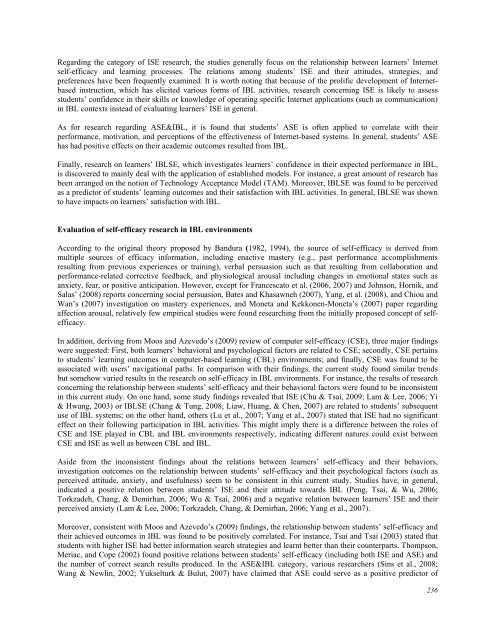October 2011 Volume 14 Number 4 - Educational Technology ...
October 2011 Volume 14 Number 4 - Educational Technology ...
October 2011 Volume 14 Number 4 - Educational Technology ...
Create successful ePaper yourself
Turn your PDF publications into a flip-book with our unique Google optimized e-Paper software.
Regarding the category of ISE research, the studies generally focus on the relationship between learners’ Internet<br />
self-efficacy and learning processes. The relations among students’ ISE and their attitudes, strategies, and<br />
preferences have been frequently examined. It is worth noting that because of the prolific development of Internetbased<br />
instruction, which has elicited various forms of IBL activities, research concerning ISE is likely to assess<br />
students’ confidence in their skills or knowledge of operating specific Internet applications (such as communication)<br />
in IBL contexts instead of evaluating learners’ ISE in general.<br />
As for research regarding ASE&IBL, it is found that students’ ASE is often applied to correlate with their<br />
performance, motivation, and perceptions of the effectiveness of Internet-based systems. In general, students’ ASE<br />
has had positive effects on their academic outcomes resulted from IBL.<br />
Finally, research on learners’ IBLSE, which investigates learners’ confidence in their expected performance in IBL,<br />
is discovered to mainly deal with the application of established models. For instance, a great amount of research has<br />
been arranged on the notion of <strong>Technology</strong> Acceptance Model (TAM). Moreover, IBLSE was found to be perceived<br />
as a predictor of students’ learning outcomes and their satisfaction with IBL activities. In general, IBLSE was shown<br />
to have impacts on learners’ satisfaction with IBL.<br />
Evaluation of self-efficacy research in IBL environments<br />
According to the original theory proposed by Bandura (1982, 1994), the source of self-efficacy is derived from<br />
multiple sources of efficacy information, including enactive mastery (e.g., past performance accomplishments<br />
resulting from previous experiences or training), verbal persuasion such as that resulting from collaboration and<br />
performance-related corrective feedback, and physiological arousal including changes in emotional states such as<br />
anxiety, fear, or positive anticipation. However, except for Francescato et al. (2006, 2007) and Johnson, Hornik, and<br />
Salas’ (2008) reports concerning social persuasion, Bates and Khasawneh (2007), Yang, et al. (2008), and Chiou and<br />
Wan’s (2007) investigation on mastery experiences, and Moneta and Kekkonen-Moneta’s (2007) paper regarding<br />
affection arousal, relatively few empirical studies were found researching from the initially proposed concept of selfefficacy.<br />
In addition, deriving from Moos and Azevedo’s (2009) review of computer self-efficacy (CSE), three major findings<br />
were suggested: First, both learners’ behavioral and psychological factors are related to CSE; secondly, CSE pertains<br />
to students’ learning outcomes in computer-based learning (CBL) environments; and finally, CSE was found to be<br />
associated with users’ navigational paths. In comparison with their findings, the current study found similar trends<br />
but somehow varied results in the research on self-efficacy in IBL environments. For instance, the results of research<br />
concerning the relationship between students’ self-efficacy and their behavioral factors were found to be inconsistent<br />
in this current study. On one hand, some study findings revealed that ISE (Chu & Tsai, 2009; Lam & Lee, 2006; Yi<br />
& Hwang, 2003) or IBLSE (Chang & Tung, 2008; Liaw, Huang, & Chen, 2007) are related to students’ subsequent<br />
use of IBL systems; on the other hand, others (Lu et al., 2007; Yang et al., 2007) stated that ISE had no significant<br />
effect on their following participation in IBL activities. This might imply there is a difference between the roles of<br />
CSE and ISE played in CBL and IBL environments respectively, indicating different natures could exist between<br />
CSE and ISE as well as between CBL and IBL.<br />
Aside from the inconsistent findings about the relations between learners’ self-efficacy and their behaviors,<br />
investigation outcomes on the relationship between students’ self-efficacy and their psychological factors (such as<br />
perceived attitude, anxiety, and usefulness) seem to be consistent in this current study. Studies have, in general,<br />
indicated a positive relation between students’ ISE and their attitude towards IBL (Peng, Tsai, & Wu, 2006;<br />
Torkzadeh, Chang, & Demirhan, 2006; Wu & Tsai, 2006) and a negative relation between learners’ ISE and their<br />
perceived anxiety (Lam & Lee, 2006; Torkzadeh, Chang, & Demirhan, 2006; Yang et al., 2007).<br />
Moreover, consistent with Moos and Azevedo’s (2009) findings, the relationship between students’ self-efficacy and<br />
their achieved outcomes in IBL was found to be positively correlated. For instance, Tsai and Tsai (2003) stated that<br />
students with higher ISE had better information search strategies and learnt better than their counterparts. Thompson,<br />
Meriac, and Cope (2002) found positive relations between students’ self-efficacy (including both ISE and ASE) and<br />
the number of correct search results produced. In the ASE&IBL category, various researchers (Sins et al., 2008;<br />
Wang & Newlin, 2002; Yukselturk & Bulut, 2007) have claimed that ASE could serve as a positive predictor of<br />
236

















